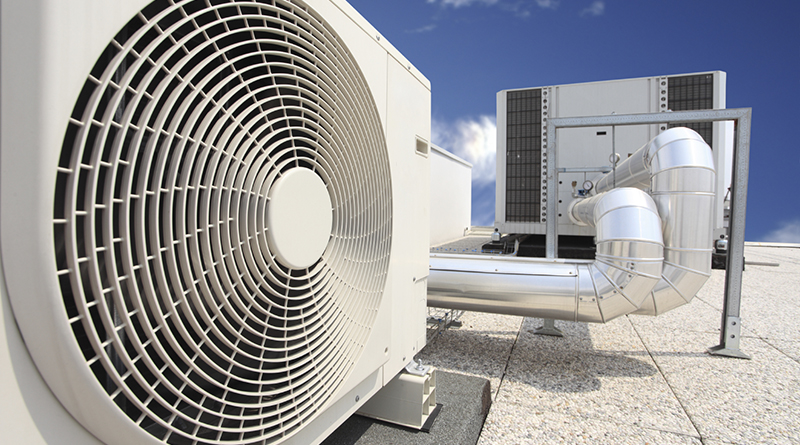Kentucky School Reaps Benefits of Innovative HVAC System

WINCHESTER, Ky. — Clark County Public Schools in Winchester recently improved upon its existing chilled beam energy-saving system by conducting retrofits on the Robert D. Campbell Junior High School HVAC system. The 43-year-old school building was relieved of its 1970s-era unit ventilators and now features chilled beams and dedicated outdoor air systems (DOAS). While neither are new technologies, Campbell is the first known building in the world to use smart, plug-and-play controllable chilled beam pump modules (CCBPM).
Using CCBPMs in Campbell’s two-phase HVAC retrofit has already saved the school district an estimated $147,000 in labor installation costs since 2015 versus the alternative of variable refrigerant flow (VRF) technology, according to a statement by project partner SEMCO, a global air movement, noise abatement, energy efficiency and indoor air quality firm. The chilled beam/DOAS combination also saves the school approximately $33,000 annually when compared to its former unit ventilator system. The energy savings will be used to lower capital dollars spent on the project by $500,000, which is guaranteed by a performance contract with the Lexington, Ky., branch of Indianapolis, Ind.-based, Performance Services Inc. (PSI), the integrated design and delivery engineering contractor that led the project.
A CCBPM — which includes a powered, integrated, direct digital controller (DDC), chilled and hot water connections, valves, variable-speed electronically commutated (EC) motor pumps and smart sensors — is superior in temperature and humidity control to the original unit ventilator design, especially during season changes, according to a statement by SEMCO. The plug-and-play CCBPMs eliminate the guesswork associated with chilled beam system specification, installation, balancing and commissioning. As with most two-pipe designs, wildly fluctuating spring and fall temperatures previously resulted in uncomfortable indoor temperatures, because of the long periods of time required to switch from heating to cooling modes.

Photo Credit (all): Provided by SEMCO
Conversely, Campbell’s new system provides pinpoint tempered conditions within a one-degree tolerance, regardless of the season, because its control is based on outdoor dew point, not temperature, according to SEMCO LLC of Columbia, Mo., which manufactured the project’s 46 NEUTON CCBPMs, 212 IQHC active chilled beams and the Pinnacle 5,000-cfm DOAS units. If the OA dew point is less than or equal to 45 degrees Fahrenheit, the space latent load is satisfied by DOAS ventilation air, which is distributed through each chilled beam and controlled via its respective CCBPM. When the dew point surpasses 45 degrees Fahrenheit, the chiller is needed to maintain space conditions.
Chilled beams in school retrofits offer superior air comfort and lower costs compared to VRF systems, according to Gary Sprague, PSI’s energy management specialist and Campbell project manager. Furthermore, Clark County School District Superintendent Paul Christy, preferred a hydronic-based system versus VRF systems, because of its potential for refrigeration leaks from line sets and evaporators into classrooms and the environment. Chilled beams also have three times the lifecycle expectancy of VRF technology and lower maintenance costs because there are no fans or condensate drain lines.
Most CCBPMs are mounted above each classroom zone’s 18-inch-high, T-bar drop ceilings and typically control four ceiling flush-mounted chilled beams. Each CCBPM was centrally positioned in each zone to limit chilled beam piping circuitry and allow its front panel to swing down through a removed ceiling tile for easy access.
“Our project is best described as a three-loop system — the original pipe loop from the central plant, the take off loop to and from each CCBPM, and the loop that connects a series of four to eight chilled beams to its respective CCBPM,” said Sprague.
The third loop is a “game-changer,” according to Sprague, because the CCBPM blends and recirculates its return water within its zone to convert typical 42 degrees Fahrenheit (cooling) and 140 degrees Fahrenheit (heating) primary loop supply water temperatures to optimal 58 degrees Fahrenheit (cooling) or 100 degrees Fahrenheit (heating) chilled beam discharge temperatures, respectively. This prevents cooling mode condensation and heating season heat stratification.
The facility also uses a building management system (BMS) by Delta Controls Inc. of Surrey, British Columbia, with front-end software by Tridium of Richmond, Va., which monitors the CCBPM via Ethernet with the BACnet protocol and sends outdoor temperature/humidity information. Sprague receives alarms and periodically reviews real time and historical data from the BMS to spotlight trends and calibrate energy-efficiency improvements.

